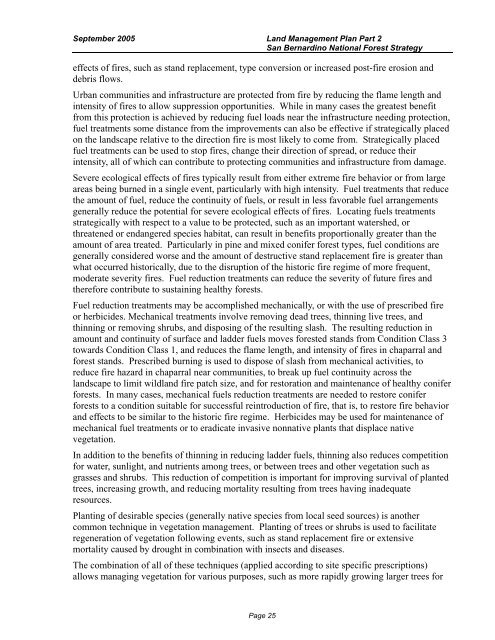San Bernardino National Forest Land Management Plan - Part 2
San Bernardino National Forest Land Management Plan - Part 2
San Bernardino National Forest Land Management Plan - Part 2
Create successful ePaper yourself
Turn your PDF publications into a flip-book with our unique Google optimized e-Paper software.
September 2005 <strong>Land</strong> <strong>Management</strong> <strong>Plan</strong> <strong>Part</strong> 2<br />
<strong>San</strong> <strong>Bernardino</strong> <strong>National</strong> <strong>Forest</strong> Strategy<br />
effects of fires, such as stand replacement, type conversion or increased post-fire erosion and<br />
debris flows.<br />
Urban communities and infrastructure are protected from fire by reducing the flame length and<br />
intensity of fires to allow suppression opportunities. While in many cases the greatest benefit<br />
from this protection is achieved by reducing fuel loads near the infrastructure needing protection,<br />
fuel treatments some distance from the improvements can also be effective if strategically placed<br />
on the landscape relative to the direction fire is most likely to come from. Strategically placed<br />
fuel treatments can be used to stop fires, change their direction of spread, or reduce their<br />
intensity, all of which can contribute to protecting communities and infrastructure from damage.<br />
Severe ecological effects of fires typically result from either extreme fire behavior or from large<br />
areas being burned in a single event, particularly with high intensity. Fuel treatments that reduce<br />
the amount of fuel, reduce the continuity of fuels, or result in less favorable fuel arrangements<br />
generally reduce the potential for severe ecological effects of fires. Locating fuels treatments<br />
strategically with respect to a value to be protected, such as an important watershed, or<br />
threatened or endangered species habitat, can result in benefits proportionally greater than the<br />
amount of area treated. <strong>Part</strong>icularly in pine and mixed conifer forest types, fuel conditions are<br />
generally considered worse and the amount of destructive stand replacement fire is greater than<br />
what occurred historically, due to the disruption of the historic fire regime of more frequent,<br />
moderate severity fires. Fuel reduction treatments can reduce the severity of future fires and<br />
therefore contribute to sustaining healthy forests.<br />
Fuel reduction treatments may be accomplished mechanically, or with the use of prescribed fire<br />
or herbicides. Mechanical treatments involve removing dead trees, thinning live trees, and<br />
thinning or removing shrubs, and disposing of the resulting slash. The resulting reduction in<br />
amount and continuity of surface and ladder fuels moves forested stands from Condition Class 3<br />
towards Condition Class 1, and reduces the flame length, and intensity of fires in chaparral and<br />
forest stands. Prescribed burning is used to dispose of slash from mechanical activities, to<br />
reduce fire hazard in chaparral near communities, to break up fuel continuity across the<br />
landscape to limit wildland fire patch size, and for restoration and maintenance of healthy conifer<br />
forests. In many cases, mechanical fuels reduction treatments are needed to restore conifer<br />
forests to a condition suitable for successful reintroduction of fire, that is, to restore fire behavior<br />
and effects to be similar to the historic fire regime. Herbicides may be used for maintenance of<br />
mechanical fuel treatments or to eradicate invasive nonnative plants that displace native<br />
vegetation.<br />
In addition to the benefits of thinning in reducing ladder fuels, thinning also reduces competition<br />
for water, sunlight, and nutrients among trees, or between trees and other vegetation such as<br />
grasses and shrubs. This reduction of competition is important for improving survival of planted<br />
trees, increasing growth, and reducing mortality resulting from trees having inadequate<br />
resources.<br />
<strong>Plan</strong>ting of desirable species (generally native species from local seed sources) is another<br />
common technique in vegetation management. <strong>Plan</strong>ting of trees or shrubs is used to facilitate<br />
regeneration of vegetation following events, such as stand replacement fire or extensive<br />
mortality caused by drought in combination with insects and diseases.<br />
The combination of all of these techniques (applied according to site specific prescriptions)<br />
allows managing vegetation for various purposes, such as more rapidly growing larger trees for<br />
Page 25
















